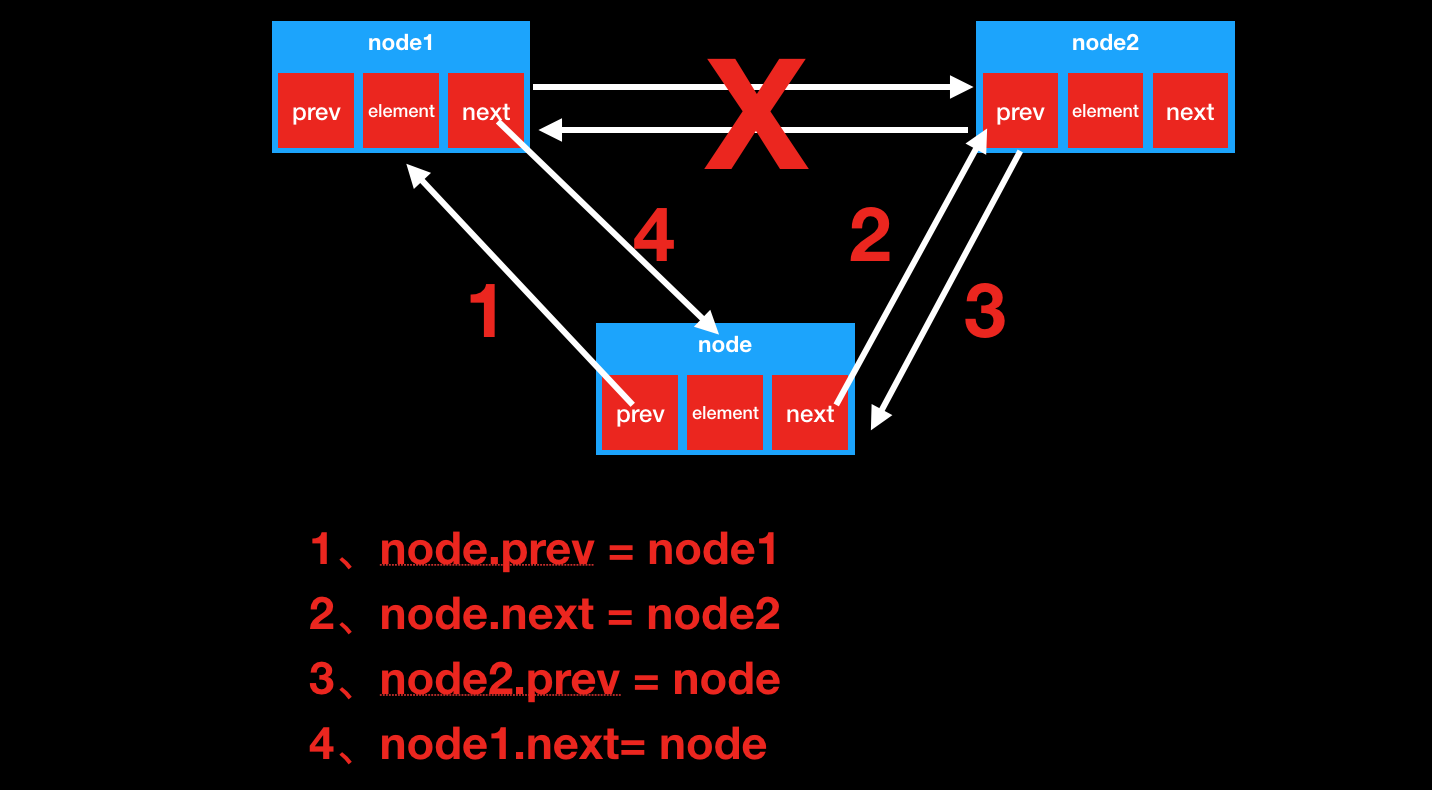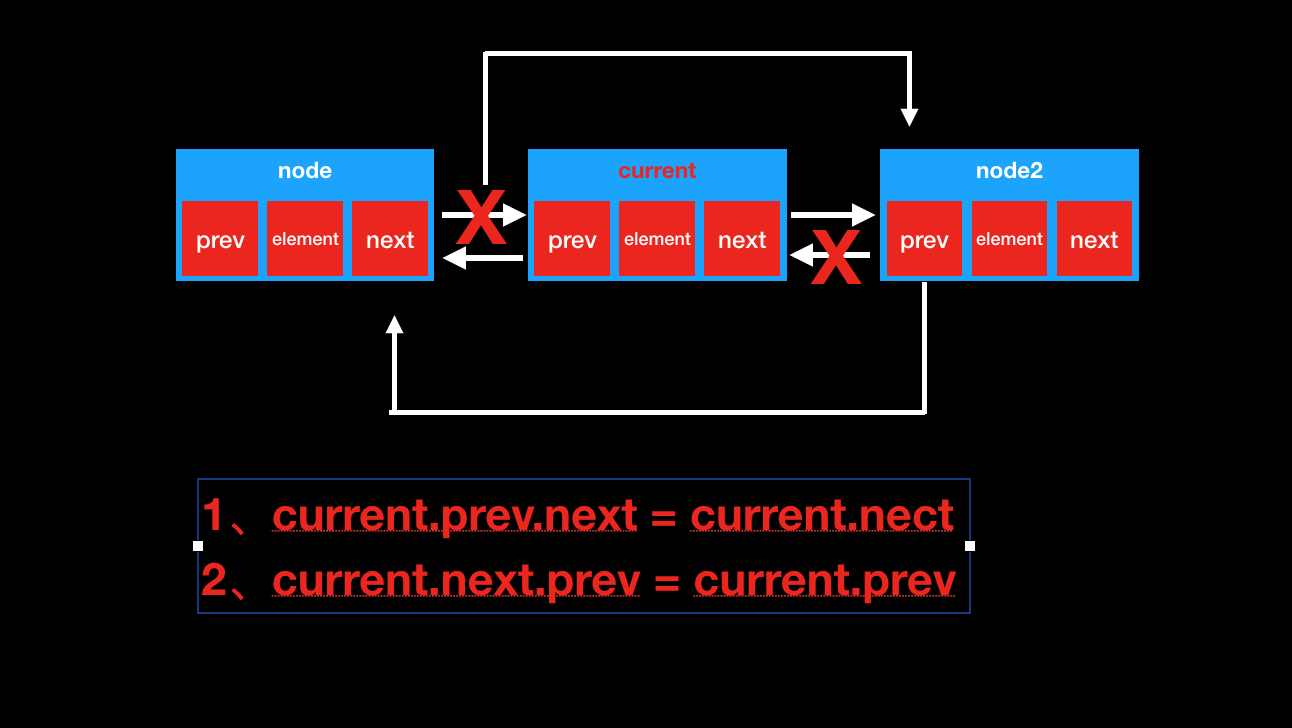python算法与数据结构-双向链表(40)
一、双向链表的介绍
一种更复杂的链表是“双向链表”或“双面链表”。每个节点有两个链接:一个指向前一个节点,当此节点为第一个节点时,指向空值;而另一个指向下一个节点,当此节点为最后一个节点时,指向空值。

上图是双向链表的结构图,即通过上一个节点可以找到下一个,通过下一个也可以找到上一个节点。
二、双向链表插入和删除的图解
1、插入图解

2、删除图解

三、双向链表的python代码实现
# 1、创建节点
class Node(object):
# 初始化方法
def __init__(self, item):
self.item= item
self.next = None
self.prev = None # 2、创建循环链表
class DoubleLinKList(object):
# 初始化方法
def __init__(self):
self._head = None # 3、判断是否为空
def is_empty(self):
"""判断链表是否为空"""
return self._head == None # 4、求其长度
def length(self):
"""返回链表的长度"""
cur = self._head
count = 0
while cur != None:
count += 1
cur = cur.next
return count # 遍历
def travel(self):
"""遍历链表"""
print("你要遍历的链表元素有:",end=" ")
cur = self._head
while cur != None:
print("%s "%cur.item,end=" ")
cur = cur.next
print("") # 5、头插
def add(self, item):
"""头部插入元素"""
node = Node(item)
if self.is_empty():
# 如果是空链表,将_head指向node
self._head = node
else:
# 将node的next指向_head的头节点
node.next = self._head
# 将_head的头节点的prev指向node
self._head.prev = node
# 将_head 指向node
self._head = node # 6、尾插
def append(self, item):
"""尾部插入元素"""
node = Node(item)
if self.is_empty():
# 如果是空链表,将_head指向node
self._head = node
else:
# 移动到链表尾部
cur = self._head
while cur.next != None:
cur = cur.next
# 将尾节点cur的next指向node
cur.next = node
# 将node的prev指向cur
node.prev = cur # 7、查找
def search(self, item):
"""查找元素是否存在"""
cur = self._head
while cur != None:
if cur.item == item:
return True
cur = cur.next
return False # 8、指定位置插入
def insert(self, pos, item):
"""在指定位置添加节点"""
if pos <= 0 or pos>self.length()+1 :
print("你输入的位置有误,请重新输入")
elif pos == 1:
self.add(item)
elif pos == self.length()+1:
self.append(item)
else:
node = Node(item)
cur = self._head
count = 1
# 移动到指定位置的前一个位置
while count < (pos - 1):
count += 1
cur = cur.next
# 将node的prev指向cur
node.prev = cur
# 将node的next指向cur的下一个节点
node.next = cur.next
# 将cur的下一个节点的prev指向node
cur.next.prev = node
# 将cur的next指向node
cur.next = node # 9、删除
def remove(self, item):
"""删除元素"""
if self.is_empty():
return
else:
cur = self._head
if cur.item == item:
# 如果首节点的元素即是要删除的元素
if cur.next == None:
# 如果链表只有这一个节点
self._head = None
else:
# 将第二个节点的prev设置为None
cur.next.prev = None
# 将_head指向第二个节点
self._head = cur.next
return
while cur != None:
if cur.item == item:
# 将cur的前一个节点的next指向cur的后一个节点
cur.prev.next = cur.next
# 将cur的后一个节点的prev指向cur的前一个节点
cur.next.prev = cur.prev
break
cur = cur.next # 验证
if __name__ == '__main__': double_link = DoubleLinKList()
# 头插
double_link.add(1)
# 遍历
double_link.travel()
# 尾插
double_link.append(2)
double_link.travel()
# 按照索引插入
double_link.insert(3,4)
double_link.travel() double_link.insert(3,3)
double_link.travel()
# 删除
double_link.remove(3)
double_link.travel()
运行结果为:
你要遍历的链表元素有: 1
你要遍历的链表元素有: 1 2
你要遍历的链表元素有: 1 2 4
你要遍历的链表元素有: 1 2 3 4
你要遍历的链表元素有: 1 2 4
四、双向链表的C语言代码实现
// main.m
// 双向链表
// Created by 侯垒 on 2019/6/28.
// Copyright © 2019 可爱的侯老师. All rights reserved. #import <Foundation/Foundation.h>
typedef struct N
{
int element;
struct N *next;
struct N *prev;
}Node; // 创建节点
Node *createNode(int num)
{
Node *node = (Node *)malloc(sizeof(Node));
node->element = num;
node->next = NULL;
node->prev = NULL;
return node;
} // 创建双向链表
Node *createDoubleLinkList(Node *node)
{
Node *head = node;
return head;
} // 判断是否为空
int is_empty(Node *head)
{
if (head == NULL)
{
return ;
}
else
{
return ;
}
} // 求其长度
int length(Node *head)
{
Node *current = head;
int count = ;
while (current != NULL)
{
count++;
current = current->next;
}
return count;
} // 遍历
void travel(Node *head)
{
printf("你要遍历的数据有:");
Node *current = head;
while (current != NULL)
{
printf("%d ",current->element);
current = current->next;
}
printf("\n");
} // 头插
Node * add(Node *head,int num)
{
Node *node = createNode(num);
if (is_empty(head)==)
{
head = node;
}
else
{
node->next = head;
head->prev = node;
head = node;
}
return head;
} // 尾插
Node* append(Node *head,int num)
{
Node *node = createNode(num);
if (is_empty(head)==)
{
head = node;
}
else
{
Node *current = head;
while (current->next != NULL)
{
current = current->next;
}
current->next = node;
node->prev = current;
}
return head;
} // 查找
int search(Node *head,int num)
{
Node *current = head;
for (int i=; i<length(head); i++)
{
if (current->element == num)
{
return i+;
}
current = current->next;
}
return ;
} // 按指定位置插入
Node * insert(Node *head ,int index,int num)
{
if (index<=||index>length(head)+)
{
printf("你要插入的位置不对,请重新插入");
}
else if (index == )
{
head = add(head, num);
}
else if (index == length(head)+)
{
append(head, num);
}
else
{
Node *node = createNode(num);
Node *current = head;
for (int i=; i<index-; i++)
{
current = current->next;
}
node->prev = current;
node->next = current->next;
current->next->prev = node;
current->next = node;
}
return head;
} // 删除元素
Node * removeNode(Node *head,int num)
{
if (is_empty(head)==)
{
printf("你要删除的链表为空");
}
else
{
Node *current = head;
//处理头结点就是要删除的节点
if (current->element == num)
{
if (current->next == NULL)
{
// 只有首节点这一个元素
head = NULL;
}
else
{
// 要删除的是首节点,但是后面还有元素
current->next->prev = NULL;
head = current->next;
}
}
else
{
while (current!=NULL)
{
if (current->element == num)
{
current->prev->next = current->next;
current->next->prev = current->prev;
break;
}
current = current->next;
}
}
}
return head;
} int main(int argc, const char * argv[]) { // 创建节点
Node *node = createNode();
// 创建链表
Node *head = createDoubleLinkList(node);
// 验证遍历
travel(head);
// 验证头插
head = add(head, );
travel(head);
// 验证尾插
head = append(head, );
travel(head); // 验证查找
int index = search(head, );
if (index != )
{
printf("你要查找的数据在%d位置\n",index);
}
else
{
printf("没有找到你要的数据\n");
} //验证按指定位置插入
head = insert(head, , );
travel(head); //验证删除
head = removeNode(head, );
travel(head);
return ;
}
运行结果为:
你要遍历的数据有:
你要遍历的数据有:
你要遍历的数据有:
你要查找的数据在2位置
你要遍历的数据有:
你要遍历的数据有:
python算法与数据结构-双向链表(40)的更多相关文章
- Python算法与数据结构--求所有子数组的和的最大值
Python算法与数据结构--求所有子数组的和的最大值 玄魂工作室-玄魂 玄魂工作室秘书 玄魂工作室 昨天 题目:输入一个整形数组,数组里有正数也有负数.数组中连续的一个或多个整数组成一个子数组,每个 ...
- python算法与数据结构-算法介绍(31)
一.算法和数据结构 什么是算法和数据结构?如果将最终写好运行的程序比作战场,我们程序员便是指挥作战的将军,而我们所写的代码便是士兵和武器. 那么数据结构和算法是什么?答曰:兵法!故,数据结构和算法是一 ...
- python算法与数据结构-单链表(38)
一.链表 链表是一种物理存储单元上非连续.非顺序的存储结构,数据元素的逻辑顺序是通过链表中的指针链接次序实现的.链表由一系列结点(链表中每一个元素称为结点)组成,结点可以在运行时动态生成.每个结点包括 ...
- python算法与数据结构-栈(43)
一.栈的介绍 栈作为一种数据结构,是一种只能在一端进行插入和删除操作.它按照先进后出的原则存储数据,先进入的数据被压入栈底,最后的数据在栈顶,需要读数据的时候从栈顶开始弹出数据(最后一个数据被第一个读 ...
- python算法与数据结构-队列(44)
一.队列的介绍 队列的定义:队列是一种特殊的线性表,只允许在表的头部(front处)进行删除操作,在表的尾部(rear处)进行插入操作的线性数据结构,这种结构就叫做队列.进行插入操作的一端称为队尾,进 ...
- python算法与数据结构-数据结构中常用树的介绍(45)
一.树的定义 树是一种非线性的数据结构,是由n(n >=0)个结点组成的有限集合.如果n==0,树为空树.如果n>0,树有一个特定的结点,根结点根结点只有直接后继,没有直接前驱.除根结点以 ...
- python算法与数据结构-二叉树的代码实现(46)
一.二叉树回忆 上一篇我们对数据结构中常用的树做了介绍,本篇博客主要以二叉树为例,讲解一下树的数据结构和代码实现.回顾二叉树:二叉树是每个节点最多有两个子树的树结构.通常子树被称作“左子树”(left ...
- python算法与数据结构-冒泡排序算法(32)
一.冒泡排序介绍 冒泡排序(英语:Bubble Sort)是一种简单的排序算法.它重复地遍历要排序的数列,一次比较两个元素,如果他们的顺序错误就把他们交换过来.遍历数列的工作是重复地进行直到没有再需要 ...
- python算法与数据结构-选择排序算法(33)
一.选择排序的介绍 选择排序(Selection sort)是一种简单直观的排序算法.首先在未排序序列中找到最小(大)元素,存放到排序序列的起始位置,然后,再从剩余未排序元素中继续寻找最小(大)元素, ...
随机推荐
- python 读写XLS
需要库: xlrd, xlwt, xlutils 导入 import xlrd from xlutils.copy import copy 打开文件 data = xlrd.open_workbook ...
- 解决:eth0安装插卡无法自己主动,网卡的配置信息不network-scripts于
问题方案:eth0安装插卡无法自己主动,网卡的配置信息不network-scripts于 解决: 1>vi /etc/rc.d/rc.loacl 最后加 ifup eth0 2>reboo ...
- Delphi Bpl包学习
对于BPL包,我个人理解是:就是一种封装方式,和DLL,EXE类似,把代码放到包(package)里面保存而已. 一.先说说如何创建BPL包 1. 打开delphi IDE(delphi7 为例) ...
- A Byte of Python(简明Python教程) for Python 3.0 下载
A Byte of Python v1.92 (for Python 3.0) 官方下载地址,当前(20120730) 最新版本 1.92 基于Python3的 下载: http://files.s ...
- 跟我学ASP.NET MVC之九:SportsStrore产品管理
摘要: 在这篇文章中,我将继续完成SportsStore应用程序,让站点管理者可以管理产品列表.我将添加创建.修改和删除产品功能. 本篇文章将分模块的方式,逐个介绍SportsStore站点管理功能的 ...
- ASP.NET Core Identity 配置 - ASP.NET Core 基础教程 - 简单教程,简单编程
原文:ASP.NET Core Identity 配置 - ASP.NET Core 基础教程 - 简单教程,简单编程 ASP.NET Core Identity 配置 上一章节我们简单介绍了下 Id ...
- Monthly Expense
Problem Description Farmer John is an astounding accounting wizard and has realized he might run out ...
- Headless Chrome入门
原文地址:Getting Started with Headless Chrome By EricBidelman Engineer @ Google working on web tooling ...
- cocos2D-X从的源代码的分析cocos2D-X学习OpenGL(1)----cocos2D-X渲染架构
个人原创.欢迎转载,转载请注明原文地址http://blog.csdn.net/bill_man 从本篇文章開始,将分析cocos2D-X 3.0源码,第一部分是从cocos2D-X学习OpenGL ...
- IIS运行WCF服务报错
试图加载格式不正确的程序 image 解决方法 image HTTP 错误 500.19 image 解决方法在控制面板————>程序————>启用或关闭windows功能—— ...
